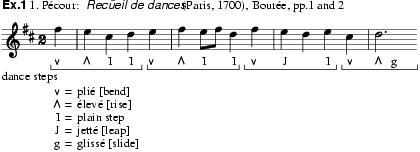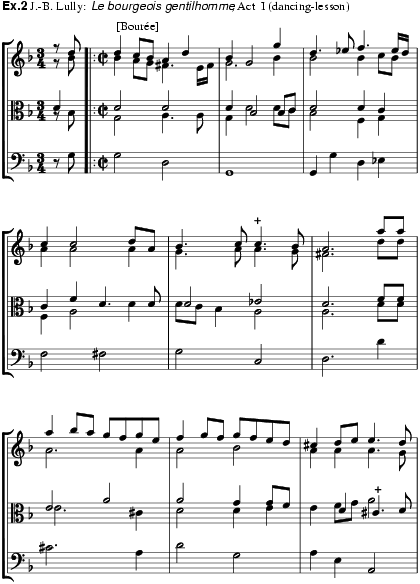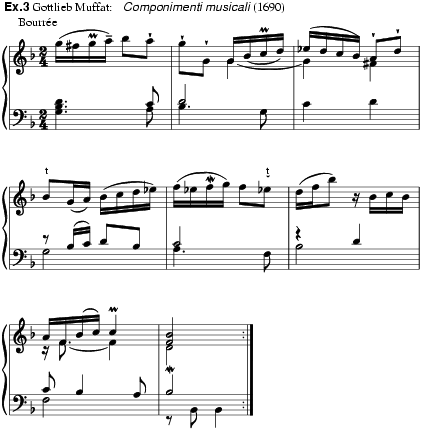
(Fr.; It. borea; Eng. boree, borry).
A French folk dance, court dance and instrumental form, which flourished from the mid-17th century until the mid-18th. The word was generally ‘bourée’ in French; the preferred current spelling may in fact be of German origin. As a folkdance it had many varieties, and dances called bourrée are still known in various parts of France; in Berry, Languedoc, Bourbonnais and Cantal the bourrée is a duple-metre dance, while in Limousin and the Auvergne it is commonly in triple metre. Many historians, including Rousseau (1768), believed that the bourrée originated in the Auvergne as the characteristic Branle of that region, but others have suggested that Italian and Spanish influences played a part in its development. It is not certain if there is a specific relationship between the duple French folkdance and the court bourrée.
Specific information on the bourrée as a court dance is available only for the 18th century, whence at least 32 choreographies entitled bourrée, bourée, boree or ‘bouree time’ are extant, both for social dancing and for theatrical use (see Little and Marsh). The bourrée was a fast duple-metre courtship dance, with a mood described variously as ‘gay’ (Rousseau, Dictionaire de musique, 1768) and ‘content and self-composed’ (Mattheson, Der vollkommene Kapellmeister, 1739). The step pattern common to all bourrées, which also occurred in other French court dances, was the pas de bourrée. It consisted of a demi-coupé (a plié followed by an élevé on to the foot making the next step), a plain step, and a small gentle leap. These three steps occurred with the first three crotchets of a bar, whether in the duple metre of a bourrée or the triple metre of a sarabande, where the pas de bourrée was also used. If the small leap was replaced by a plain step, the pattern resulting was called a fleuret. The pas de bourrée preceded the fleuret historically, and is somewhat more difficult to execute; by the early 18th century, however, the two steps seem to have been used interchangeably, according to the dancer’s ability. The bourrée as a social dance was a mixture of fleurets, pas de bourrées, leaps, hops and the tems de courante (a gesture consisting of a bend, rise and slide; see Courante) at places of repose. Ex.1 shows the opening phrase of the Bourrée d’Achille (Little and Marsh, no.1480), a popular ball dance from 1700 which was actually part of a suite of three dances (bourrée–minuet–bourrée) from the Prologue to the Lully-Collasse opera Achille et Polyxène (1687). Each of the first two bars contains a pas de bourrée, the third has a hop and two plain steps, and the fourth a tems de courante. Thus the rhythmic shape of the phrase is that of three active bars followed by a point of arrival at the beginning of the fourth bar and a subsequent relaxation of effort. A complete bourrée consisted of two strains, each containing one or more four- or eight-bar phrases with a rhythmic shape as described. Each dance, however, had a separate choreography with a unique mixture of the possible steps.

Some form of the bourrée was danced at French court festivals by natives of the Auvergne as early as the mid-16th century. It was eventually also used, probably in a more refined form, in the ballet de cour. The Philidor Collection contains a ‘Bourrée d’Avignon’ (i, 51–2) which was probably a dance accompaniment, and the Ballet de la delivrance de Renaud (1617) also contains a bourrée for dancing. Collections of airs de cour such as L’élite des airs de cour (1608) and Le recueil des plus belles chansons (1615) include texts for sung bourrées, showing the growing popularity of the dance’s characteristic rhythms. Under Louis XIV the bourrée came into fashion both as a social dance at balls and as a theatrical dance. Lully included bourrées in many of his ballets and operas, such as Les amours déguisés (1664), La naissance de Vénus (1665) and Phaëton (1683), and he composed one for the dancing-lesson scene in Act 1 of Molière’s Le bourgeois gentilhomme (1670). Later French composers for the stage, including Charpentier, Destouches, Campra and Rameau, continued to use bourrées in dancing-scenes and occasionally in overtures.
As stylized dance music, the Baroque bourrée was characterized by duple metre (a time signature of 2 or ) with an upbeat of a crotchet, a moderate to fast tempo (minim = c80–92) and phrases built out of four-bar units with a point of arrival at the beginning of the fourth bar (seventh minim). A performance style in which quavers were inégales (stepwise-moving passages of quavers unmixed with other values to be played unevenly over a steady beat) is thought to have been common for the bourrée, particularly in France. These characteristics also apply to the Rigaudon, and indeed Quantz virtually equated the dances, but the two types can be distinguished because the rigaudon was slightly more vigorous and tended to have more angular melodies than the bourrée. Moreover, 18th-century writers (Rousseau, Mattheson etc.) consistently mentioned a crotchet–minim syncopation used to emphasize the third or seventh beat of a phrase as characteristic of the bourrée, a trait which would easily distinguish a bourrée from a rigaudon. Ex.2, Lully’s bourrée for Le bourgeois gentilhomme, shows the characteristic syncopation, phrase structure and homophonic texture.

The stylized bourrée flourished as an instrumental form from the early 17th century. Praetorius’s Terpsichore (1612) included a few examples, all with quite simple phrasing and a homophonic texture. The Kassel Manuscript (ed. J. Ecorcheville, Vingt suites d’orchestre, 1906/R) also contains a number of bourrées, often placed as the second dance in a suite. As the order of dances in a suite became conventionalized into the familiar allemande–courante–sarabande group (see Suite, §5), the bourrée continued to be included fairly often, coming after the sarabande with other less serious dances like the minuet and the gavotte. In that position it was included in orchestral suites by J.C.F. Fischer, Johann Krieger, Georg Muffat and J.S. Bach. Three of Bach’s orchestral suites include pairs of bourrées, in which the first is to be repeated (‘bourrée da capo’) after the second is played, a common treatment of the so-called popular dances in the suite. Other bourrées occur in his English and French suites for keyboard, in two of the solo suites for cello, and in the Partita for solo flute (see Little and Jenne). Handel’s Water Music includes a bourrée that hardly seems at all stylized.
Baroque keyboard versions of the bourrée often took liberties with the original simplicity of the dance form. Such composers as Lebègue, D’Anglebert, Purcell, Gottlieb Muffat, Bach and Domenico Scarlatti wrote bourrées, many highly ornamented with some idiomatic display of keyboard technique. Yet even those like ex.3 (from Muffat’s Componimenti musicali, 1690) which show no trace of the bourrée’s characteristic crotchet–minim syncopation retain a fairly simple homophonic texture and a clear phrase structure based on four-bar units. Bourrée style persisted well into the late 18th century, as the opening movement of Mozart's G minor Symphony well illustrates. In the 19th and 20th centuries some composers wrote pieces entitled bourrée, apparently as a reference to the French folkdances rather than to the Baroque court dance and instrumental form: Chabrier’s Bourrée fantasque, in its fast duple metre and strict adherence to four-bar phrases, suggests that the composer may have sought to evoke the court bourrée; the movement labelled ‘bourrée’ in Roussel’s Suite pour piano op.14, however, a rapid triple-metre dance with asymmetrical phrases, bears no resemblance to the Baroque form.

G. Taubert: Rechtschaffener Tanzmeister (Leipzig, 1717)
P. Rameau: Le maître à danser (Paris, 1725; Eng. trans., 1931/R)
J. Canteloube: ‘La danse d’Auvergne’, Auvergne littéraire, artistique et historique, iv (1936)
L. Horst: Pre-Classic Dance Forms (New York, 1937/R)
C. Sachs: Eine Weltgeschichte des Tanzes (Berlin, 1933; Eng. trans., 1937/R)
W. Hilton: Dance of Court and Theater (Princeton, NJ, 1981/R)
B. Mather: Dance Rhythms of the French Baroque (Bloomington, IN, 1987), 214–20
M. Little and N. Jenne: Dance and the Music of J.S. Bach (Bloomington, IN, 1991), 35–46
M. Little and C. Marsh: La danse noble: an Inventory of Dances and Sources (Williamstown, MA, 1992)
F. Lancelot: La belle dance: catalogue raisonné (Paris, 1996)
MEREDITH ELLIS LITTLE